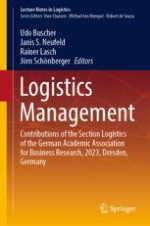2023 | Buch
Logistics Management
Contributions of the Section Logistics of the German Academic Association for Business Research, 2023, Dresden, Germany
herausgegeben von: Udo Buscher, Janis S. Neufeld, Rainer Lasch, Jörn Schönberger
Verlag: Springer Nature Switzerland
Buchreihe : Lecture Notes in Logistics
